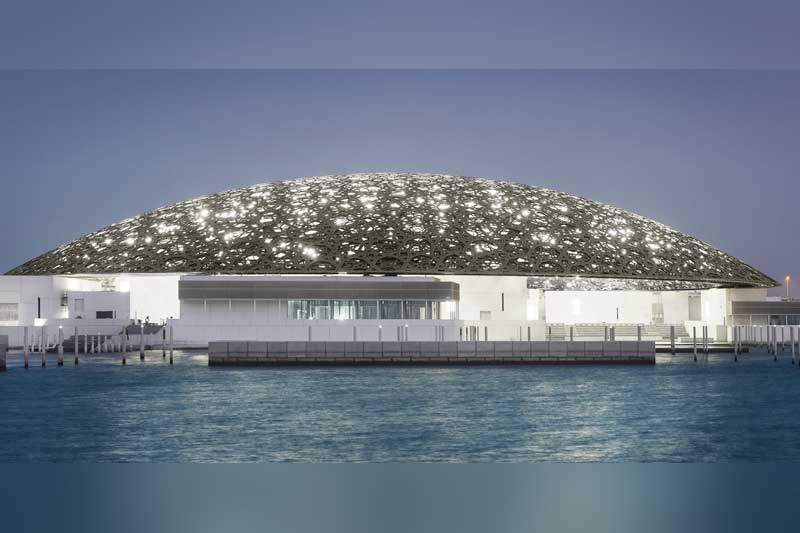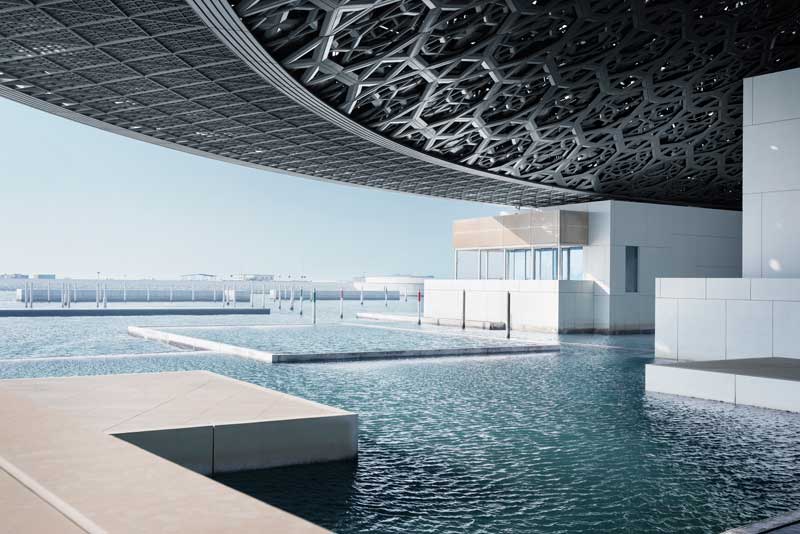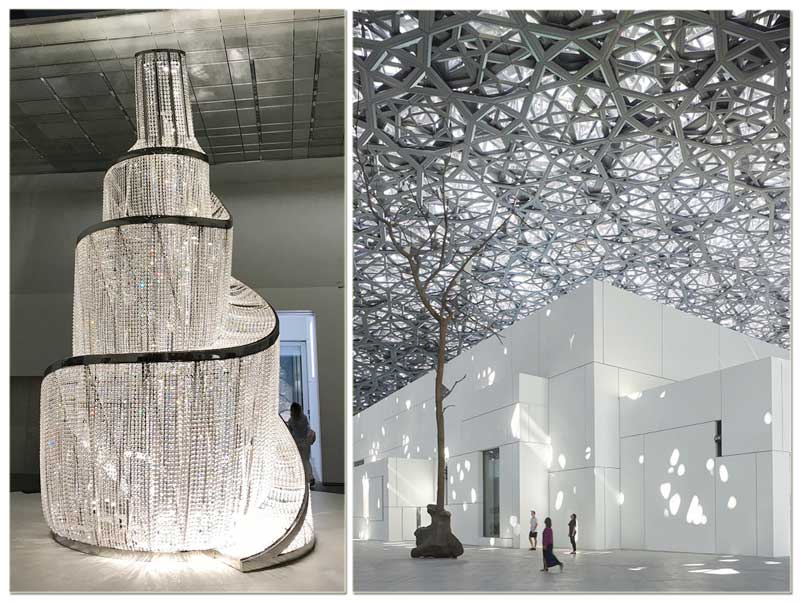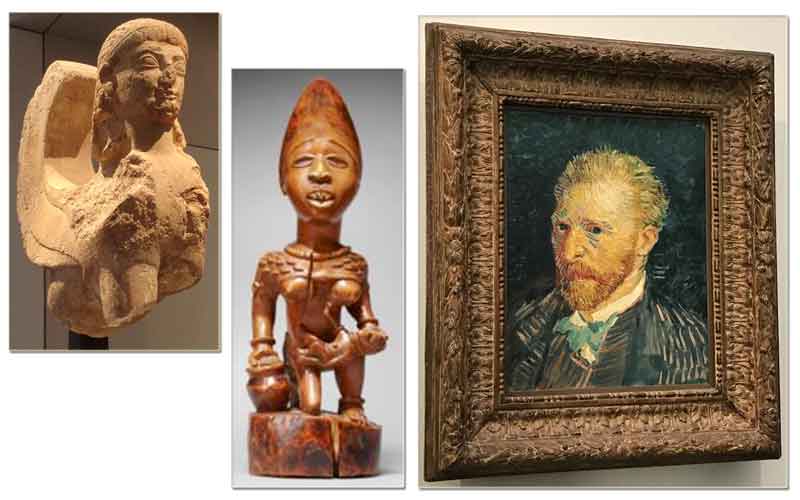An Oasis of Arts in The Desert

The Louvre Abu Dhabi is itself a work of art. Its unique façade lights up Abu Dhabi’s ever-changing skyline. The museum is a cluster of 55 buildings, all galleries, with a total of 6,400 square meters of exhibit space.
MANILA, Philippines — Look up the minute you enter and be blown away by a canopy of 7,850 unique stars. The stainless steel and aluminium ceiling of the metallic silver dome – a major symbol of the structure – with eight layers of cladding, provides much-needed shade peppered by sparse rays of sunlight at interesting angles, giving the sensation of the leaves of swaying palm trees or the temporary shelter of the captivating souks.
Welcome to the Louvre Abu Dhabi.
The genius behind this low-lying open-air arched roof of 180 meters and 7,700 tons is the Pritzer Prize-winning architect Jean Nouvel.
This architectural marvel of a museum was built on a dry dock of 24,000 square meters on the Saadiyat Cultural District with a cluster of 55 minimalistic buildings, all separate galleries, geographically independent of one another, interspersed on several sides by sparkling seawater. It has 6,400 square meters of galleries.
Spanning a total of ten years of negotiation and planning, two years of construction and the employment of over 800 workers at a time, it finally opened its doors to the public in November 2017. It was inaugurated in the presence of the UAE Vice President, Prime Minister and Ruler of Dubai, His Highness Sheikh Mohammed bin Rashid Al Maktoum; His Highness Sheikh Mohamed bin Zayed Al Nahyan, Crown Prince of Abu Dhabi and Deputy Supreme Commander of the UAE Armed Forces; and President of France Emmanuel Macron.
The exact cost of this noble project is unknown. However, resident friends in the Emirates who heard it through the grapevine, ventured the undertaking reached a grand total of €1 Billion.
A portion of the expenditures are dedicated to art loans and art shows – four are scheduled per year for 15 years – to include the temporary exchange of between 200 to 300 masterpieces.

This includes the entire package, such as being associated with the Louvre branding – this is the first museum to bear the Louvre name outside France – as well as management advice, plus a generous donation to the French sister structure to refurbish an entire wing.
Still the Louvre in Paris and the Louvre Abu Dhabi are two separate entities. Linked by a 30-year government-to-government contract, the Middle Eastern counterpart may borrow artworks from 13 leading French institutions.
And now, to the 12 chapters across the museum’s galleries, which starts with the infancy and climaxes to the eventual flourish of civilization.
The First Villages, The First Great Powers and Civilizations and Empires lay down the foundations of humanity’s first brush with the concept of togetherness and community, traditions and customs and, finally, rule and authority.
A favorite of many is the sarcophagus of the Egyptian Queen Henuttawy which alludes to the observance of ancient rituals even back then.
This is my first time to witness ancient leaves and pages from the Qur’an, the Torah and the Bible in one center stage in Universal Religions, which chronicles the rise of organized beliefs and how they forever changed ancient societies.
Travel and trade was the highlight of Asian Trade Routes, From the Mediterranean to the Atlantic and The World In Perspective, which trace the crisscrossing paths of lasting settlements as they engaged in worldwide barter, and how these voyages contributed to the fields of mathematics and science.
Leonardo Da Vinci’s La Belle Ferronniere, a portrait of an unknown woman, is a focal point of one of the chambers.

(Left)Contemporary art like Fountain of Light by Ai Wei Wei. (Right)The intricate roof of the museum, created by architect Jean Nouvel, creates a “rain of light.”
Jealousy and rivalry between nations soon sparked continental encounters, well-documented in The Magnificence of the Court, a record of the displays of power and influence exercised by royalty.
A marble Horses of the Sun sculpture and a Bronze Oba Head from the Kingdom of Benin – now Nigeria – both exemplify supremacy.
A New Art of Living took us to the industrial age, where the sheer amount of mass manufactured goods all over the globe coincided with the era when individuals and families became more obsessed with intellect.
Of prominence is an oil-on-canvas painting by Jacques-Louis David of First Consul Napoleon Bonaparte Crossing the Alps on May 20, 1800.
The last galleries – A Modern World, Challenging Modernity and Global Stage – is a step-by-step account on how the advances in technology challenged artists to radically alter their presentations, the constant reinvention of concepts and finally, the influence of mass media and the internet in breaking down borders to spread a multicultural and multifaceted image of the world of art.
Vincent Van Gogh’s Self Portrait and Piet Mondrian’s Composition with Blue, Red, Yellow and Black masterfully display the out-of-the-box style of artists of the moment.
Other notable highlights include The Saint-Lazare Station by Claude Monet, Giovanni Bellini’s Madonna and Child and soon, Da Vinci’s Salvator Mundi, a painting of Christ which recently hit the gavel at $450.3 million, smashing all previous auctioned art prices.

The museum’s collection ranges from an archaic Sphinx made of shell limestone and Phemba, a maternity figure (left, insets); a self-portrait by Vincent Van Gogh .
Contemporary artists may call this their haven, as exemplified by For Louvre Abu Dhabi by Jenny Holzer, a recipient of the Leone d’Oro at the Venice Biennale in 1990, the World Economic Forum’s Crystal Award in 1996 and the Barnard Medal of Distinction in 2011, and Germination, by Giuseppe Penone, who has participated in a retrospective at MoMA in 1970, four Documentas in Kassel since 1972, five Venice Biennales from 1978 and exhibitions at the Centre Pompidou in 2004, the Whitechapel Gallery in London in 2012 and the Château de Versailles in 2013.
A popular stopover is the café inspired by the Op-Art movement of the 1960s. It blends beautifully with the rest of the museum, for from certain angles, the hub may seem entirely black and white, but from other vantage points, the room blooms into full color.
Special exhibitions, an Art Club, a Children’s Museum, a series of Family Workshops and almost unlimited references for educational institutions likewise serve the core purpose of the museum – all ventures equally worthy to be advocacies.
The Louvre Abu Dhabi lives up to the name of what Abu Dhabi best represents – the grandest, the unsurpassed, the unrivaled and the incomparable. Photos of artworks by Edu Jarque. Additional photos courtesy of The Louvre Abu Dhabi
* * *
The Louvre Abu Dhabi is open from 10 a.m. to 8 p.m. on Saturdays, Sundays, Tuesdays and Wednesdays, and from 10 a.m. to 10 p.m. on Thursdays and Fridays. The museum is closed on Mondays.
- Latest
- Trending


















